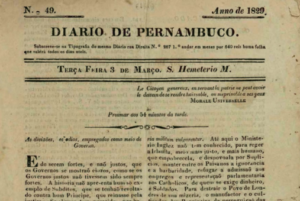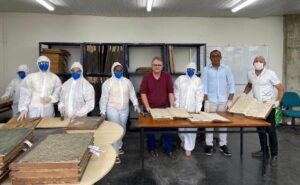As the oldest newspaper in circulation in Latin America prepares to celebrate its 200-year anniversary amid a media crisis and its own financial struggles, local journalists hope that a recent recognition of the Diario de Pernambuco’s archive as material cultural heritage will help it stay afloat.

Diario de Pernambuco is about to celebrate 200 years of circulation. (Photo: Agência Senado)
“It is the first newspaper in Portuguese-speaking countries to be recognized as a country's national heritage, it is very important. The newspaper saw the monarchy, it saw the monarchy fall, it saw pandemics, it saw wars. It told and still tells the story of Brazil and the people who are here,” Múcio Aguiar, former director of journalism at the newspaper and president of the Pernambuco Press Association (AIP for its initials in Portuguese), told LatAm Journalism Review (LJR).
Despite its long history, the publication has not been spared financial and legal challenges. Dozens of journalists have been laid off in recent years and the newspaper faces legal challenges from former employees who say they are owed payment, as well as an investigation by labor prosecutors in Pernambuco.
The designation as cultural heritage does not guarantee the legal protection of the archive. In Brazil, a collection can be recognized as heritage for its historical and cultural relevance, but to receive full legal protection, it needs to be officially protected, and the law awarded to the newspaper does not include that protection.
Still, the recognition is seen by local journalists and the newspaper's administration as a potential lifeline for Diario de Pernambuco, and its archive, through the search for financial incentives, partnerships and support from public bodies.
The newspaper's archive consists of 2,690 volumes, and since 2022 it has undergone a conservation and digitization process as part of the Curatorship Program for the Memorial Heritage of Centenary Newspapers of Pernambuco, a partnership between AIP and the Federal University of Pernambuco (UFPE). The project is supervised by Professor Marcos Galindo from UFPE and the expectation is that it will take 10 years to complete. According to Galindo, there is an urgent need for more funding to accelerate the conservation of older publications that are deteriorating rapidly.
“Declaring the archive as heritage is important, but we really need funds,” Galindo told LJR. “Every day that passes is one less day in the life of this material. We are not talking about just any newspaper, it is one of the first in Latin America, founded by liberals, and which shows the entry of liberal thought in Brazil that culminated in the Republic. There is a lot about slavery, the industrial revolution, cultural issues with writers of the time. Imagine the value that has.”
Diario de Pernambuco was founded on Nov. 7, 1825 by typographer Antonino José de Miranda Falcão in Recife, capital of Pernambuco, in Northeast Brazil. Initially, it was created as an advertisement sheet, with notices of the purchase and sale of properties, objects, auctions, rentals, robberies, lost and found, escapes and seizures of slaves, trips, in addition to reporting the entry and exit times of vessels in the Port of Recife.

Professor Marcos Galindo and his team work to restore the archive of Diario de Pernambuco. (Photo: Federal University of Pernambuco)
“For 300 years, Pernambuco was the engine of the country's economy and was also an important port, the first port of arrival here from Europe, so the news arrived here first. This material is a portrait of Brazil,” Galindo said.
The bill that resulted in the recognition of the archive as national heritage was authored by federal deputy Eduardo da Fonte, who also allocated R$300,000 (about US $49,000) in parliamentary amendments for the UFPE memory project in 2023. Similar laws recognizing the archive are in progress at the municipal level, in Recife, which is only awaiting sanction from the mayor, and at the state level, by the Assembly of Deputies.
The current director of journalism at Diario de Pernambuco, Paula Losada, also welcomes initiatives to preserve and recognize the archive. She said the newspaper receives requests for access to the archive for books, films and academic research from all over Brazil and also internationally.
“Our archive is very rich, both photography and information. We had requests for photos of Queen Elizabeth's visit to Recife. We also provided a cover from the 1970s for Kleber Mendonça Filho's latest film. It is a reference to the history of the country and Pernambuco. This measure is very important for the maintenance and preservation of this collection, which is in a room, cataloged and stored,” Losada told LJR.
Currently, Diario de Pernambuco has 45 staff members in the newsroom, including reporters, editors, photographers, layout designers, social media professionals and interns, who work on a hybrid basis. The newspaper has a circulation of 10,000 and is published from Tuesday to Sunday. It sources printing from a third party. On Mondays, only the PDF file of the print version is available. With the pandemic, the newspaper was reduced in size, leading to a reduction in advertising space.
Diario de Pernambuco also changed ownership. In September 2019, it was purchased by lawyer Carlos Frederico Vital from brothers Alexandre Rands and Maurício Rands, from the R2 group, who had managed the publication since October 2015. The change in management came in the wake of the intensification of the newspaper's financial crisis, which worsened in 2018, when 38 employees were fired from the newsroom.
According to Vital, the recognition of the archive as material cultural heritage is an advantage for the company in terms of consolidating the brand in the country. The lawyer also defends the changes that have been made to the newspaper since he took over as owner, such as the reduction in staff and the focus on digital and social media. For 2025, he told LJR he wants to implement a new platform for the website, one that’s “more modern,” and focus increasingly on digital.
“The biggest thing for us is the website, because it gives a return on visualization,” he said. “I've been the owner for five years and we've been fighting hard. When we took over there was a lot of difficulty, these are things that are being well taken care of now, like a lean editorial team, which was absurd and could not be sustained, incompatible with the reality of the company.”
A new wave of layoffs took place in September 2023, with five professionals dismissed. According to the Union of Professional Journalists of the State of Pernambuco (Sinjope), one was owed 17 paychecks. On the same occasion, Sinjope reported that its president, Jailson da Paz, and former president, Osnaldo Moraes were removed from their roles within the newsroom to join a group at the newspaper commemorating the 200th anniversary of Diario de Pernambuco. Delays in paychecks also continue to be reported among employees.
“I myself haven’t been paid for four months. The last paycheck I received was on Aug. 22,” Paz told LJR. “The last information we obtained, in November, was R$32 million (about US$5.2 million) in labor debts. Diario de Pernambuco today is a box of labor irregularities, unfortunately. Many people continue to work there because the market is bad and people need to survive.”
In November, the Regional Labor Court of the 6th Region (TRT-6) approved the adoption of a special measure to speed up the payment of labor debts at Diario de Pernambuco. There are more than 300 labor actions against the company already in the final phase, and the court will concentrate them all in a single procedure. The goal is to ensure that workers receive what is owed to them.

Diario de Pernambuco continues to publish after almost two centuries. (Screenshot of front page)
According to Flavio Koury, legal vice-president of Diario de Pernambuco, the newspaper is in negotiations to start making monthly contributions to a judicial account to gradually reduce labor liabilities until it is able to sell the headquarters building and pay off the entire debt.
“We are looking to start with R$80,000 (about US$13,000) to pay off the debt, starting in January or February, depending on cash flow. And our prediction and intention is to settle all labor liabilities with the sale of the property where the printing company was located, in Santo Amaro, here in Recife, which is valued at R$ 27 million (about US$4.4 million),” Koury said.
In July, the Public Prosecutor’s Office of Labor in Pernambuco (MPT-PE) opened a case against Diario de Pernambuco on suspicion of "pejotização," accusing the newspaper of hiring employees as legal entities to avoid employment relationships and labor rights provided for by law. The action seeks to force the newspaper to regularize the workers' situation.
Abel da Hora, labor lawyer for Diario de Pernambuco, said there is resistance from the public prosecutor’s office to “new situations” in the labor market.
“The public prosecutor’s office is collecting evidence, we present our defense. We argue that what we are doing is normal and legal, based on several decisions of the Supreme Federal Court (STF) since the 2017 labor reform, which defined that outsourcing is legal in certain situations,” da Hora told LJR.
For the future of Diario de Pernambuco, Vital wants to implement a new platform for reporters to work and upload stories to the website, “more modern” and similar to those used by larger newsrooms. He also wants to focus more and more on digital, relying on digital advertising and online access to ensure financial sustainability, and dreams of creating an app for the publication.
“It's a constant struggle, a 200-year-old company that is alive, is breathing. When I joined, the idea was to close due to the unmanageable debt. I still had two years of pandemic, with a number of employees that didn't fit with what the company could handle, which needed to be cleaned up,” said Vital, who despite focusing on digital, wants to keep the print publication in circulation.
“It will circulate! Despite not making a profit and not sustaining the newsroom's operations, the print publication pays for itself. If the newspaper does not circulate, it loses precisely what it has. The 200 years are important because it is a newspaper in circulation.”